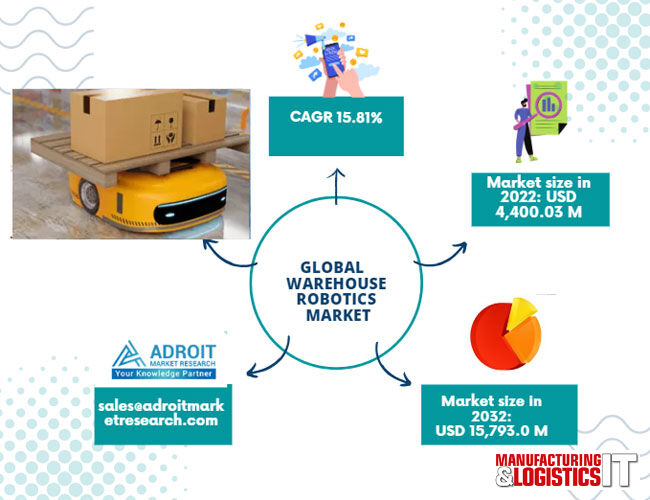According to Adroit Market Research, with a predicted 15.81% CAGR from 2021 to 2030, the global warehouse robotics market was valued at USD 4,400.03 million in 2020 and is expected to reach USD 15,793.0 million by 2030.
In a warehouse or distribution center, robotic systems and automation technologies are used to carry out various jobs and operations. These robots are made to simplify and improve a number of warehouse tasks, including material handling, order fulfilment, and inventory management. The logistics and supply chain sector may benefit greatly from warehouse robotics in terms of increased productivity, accuracy, and efficiency.
Robotics and warehouse automation are in high demand as a result of the increasing growth of e-commerce. Robotics is a crucial component of the logistics infrastructure for e-commerce businesses since they have to handle a large number of orders quickly and precisely. Businesses from a variety of industries are trying to increase productivity, lower labor costs, and enhance overall supply chain operations. It is harder to locate and keep competent personnel when there are labor shortages in storage and logistics across several locations. To fill this labor shortage, warehouse robots are a potential answer. Robotics, artificial intelligence (AI), machine learning, and sensor technologies are constantly improving, making robots more powerful, adaptable, and economical for warehouse applications.
Warehouses now handle a broader variety of goods in various sizes and forms. Robots with vision systems and flexible grippers are capable of handling these various goods with ease. Pressure to process and distribute orders more rapidly has been placed on warehouses by customer expectations for speedier delivery times. Robots’ ability to expedite order fulfilment procedures aids in meeting these needs. Cobots, or collaborative robots, are becoming more and more commonplace. These robots include security measures to guarantee workers’ safety while boosting efficiency. Automation and robotics usage in warehouses was pushed by the COVID-19 epidemic as businesses attempted to minimize human interaction and improve operational resilience.
Developed countries are not the only ones using warehouse robotics; emerging markets are also spending more money on automation to boost their logistical capabilities. Since automation may help optimise energy consumption and minimize waste in warehouse operations, several businesses are turning to robotics as part of their sustainability initiatives. For the unique requirements of various sectors and warehouse sizes, robotics businesses are providing more scalable and customised solutions.
For robotics firms, entering new countries with rising storage and logistics demands might be a lucrative opportunity. Automation is a growing area of investment for many nations as they work to strengthen their supply chains. A prospective growing area is the application of robots to warehouse security, including monitoring, intrusion detection, and tamper-evident packaging. Automation and robots can be used to facilitate the effective transfer of products across borders for international e-commerce transactions, opening up potential in customs clearance and logistics. Businesses may make data-driven decisions for optimization by developing analytics solutions that offer insightful data on warehouse operations.
The use of autonomous mobile robots (AMRs) has increased rapidly. Without the aid of stationary infrastructure like rails or cables, these robots navigated dynamically around warehouse settings using cutting-edge sensors like LiDAR and cameras. E-commerce started to alter the storage industry. Order fulfilment must now be carried out more quickly and effectively due to the rise in internet buying. Robots for warehouses have become more popular, especially those used for order picking and packing. The development of warehouse robots has been spurred by significant innovations in robotics technology, such as advances in artificial intelligence (AI), computer vision, and machine learning. Large fleets of robots were used by companies like Amazon to move merchandise and speed up order processing in their fulfilment centers. Cobots, or collaborative robots, which are made to securely operate alongside human workers, are becoming more common in warehouses.
AGVs are mobile robots that can navigate a warehouse on their own thanks to sensors and navigational systems. They are frequently employed to carry items between storage facilities, load and unload vehicles, and restock inventories. AMRs and AGVs are comparable, however, AMRs have more sophisticated autonomy. Without the need for permanent infrastructure like rails or cables, they can adapt to changing situations and avoid impediments. Order picking and other dynamic warehouse jobs frequently include the usage of AMRs. These machines are built to retrieve products from racks or bins in a warehouse. To effectively recognise and handle objects, they may employ a variety of grasping mechanisms, computer vision, and machine learning algorithms. Picking robots is essential for completing orders.



